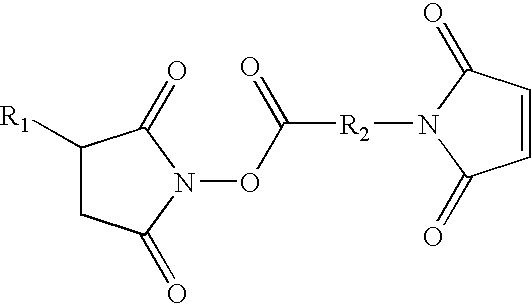Method for identifying skin care composition-resistant skin-binding peptides
a technology of skin care composition and peptides, which is applied in the field of personal care products, can solve the problems of inability to identify skin-binding peptides with lack of durability for long-lasting effects, and low concentration of bath gel used to identify bath gel-resistant skin-binding peptides
- Summary
- Abstract
- Description
- Claims
- Application Information
AI Technical Summary
Benefits of technology
Problems solved by technology
Method used
Image
Examples
examples
[0167] The present invention is further defined in the following Examples. It should be understood that these Examples, while indicating preferred embodiments of the invention, are given by way of illustration only. From the above discussion and these Examples, one skilled in the art can ascertain the essential characteristics of this invention, and without departing from the spirit and scope thereof, can make various changes and modifications of the invention to adapt it to various uses and conditions.
[0168] The meaning of abbreviations used is as follows: “min” means minute(s), “sec” means second(s), “h” means hour(s), “μL” means microliter(s), “mL” means milliliter(s), “L” means liter(s), “nm” means nanometer(s), “mm” means millimeter(s), “cm” means centimeter(s), “μm” means micrometer(s), “mM” means millimolar, “M” means molar, “mmol” means millimole(s), “μmol” means micromole(s), “g” means gram(s), “μg” means microgram(s), “mg” means milligram(s), “pfu” means plague forming un...
examples 1-3
Prophetic
Identification of Skin Conditioner-Resistant Skin-Binding Peptides
[0173] The purpose of these prophetic Examples is to describe how to identify skin conditioner-resistant skin-binding peptides from three random phage display peptide libraries, specifically, the Ph.D.-12™ Phage Display Peptide Library, the 15-mer and the 20-mer random peptide libraries.
[0174] For the process, a unique pig skin-bottom 96-well apparatus is made by applying one layer of Parafilm® under the top 96-well block of a Minifold I Dot-Blot System (Schleicher & Schuell, Inc., Keene, N.H.), adding a layer of hairless pig skin on top of the Parafilm® cover, and then tightening the apparatus. The pig skin may be purchased from a local supermarket and stored at −80° C. Before use, the skin is placed in deionized water to thaw, and then blotted dry using a paper towel. The surface of the skin is wiped with 90% isopropanol, and then rinsed with deionized water.
[0175] A sample containing approximately 4×10...
example 4
Prophetic
Specificity of Skin Conditioner-Resistant Skin-Binding Peptides
[0178] The purpose of this prophetic Example is to describe how to determine the specificity of the skin conditioner-resistant skin-binding peptides that are identified using the method described in Examples 1-3 using an ELISA procedure.
[0179] The skin conditioner resistant skin-binding peptides identified using the method described in Examples 1-3 are used along with a control peptide, an unrelated hair-binding peptide, I-B5 (Huang et al. supra), given as SEQ ID NO:3. All of the peptides are synthesized with an added lysine residue, derivatized with the fluorescent tag 5-carboxyfluorescein-aminohexyl amidite (5-FAM), at the C-terminus by SynPep (Dublin, Calif.). The sequence of the labeled I-B5 hair-binding peptide is given as SEQ ID NO:4.
[0180] For the assay, a unique hair or pig skin-bottom 96-well apparatus is created by applying one layer of Parafilm® under the top 96-well block of a Minifold I Dot-Blot...
PUM
| Property | Measurement | Unit |
|---|---|---|
| Length | aaaaa | aaaaa |
| Fraction | aaaaa | aaaaa |
| Fraction | aaaaa | aaaaa |
Abstract
Description
Claims
Application Information
 Login to View More
Login to View More - R&D
- Intellectual Property
- Life Sciences
- Materials
- Tech Scout
- Unparalleled Data Quality
- Higher Quality Content
- 60% Fewer Hallucinations
Browse by: Latest US Patents, China's latest patents, Technical Efficacy Thesaurus, Application Domain, Technology Topic, Popular Technical Reports.
© 2025 PatSnap. All rights reserved.Legal|Privacy policy|Modern Slavery Act Transparency Statement|Sitemap|About US| Contact US: help@patsnap.com

